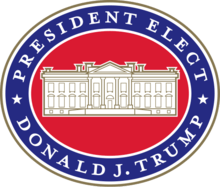Donald Trump pseudonyms
American businessman, politician and President-elect of the United States, Donald Trump has used several pseudonyms, including "John Barron" (or "John Baron") and "John Miller". His habit of sometimes speaking to the media under the guise of a spokesperson has been described as "an open secret" at the Trump Organization and in New York media circles.[1] Some New York editors recalled that "calls from Barron were at points so common that they became a recurring joke on the city desk."[2] A writer for Fortune reported that Trump's father Fred Trump had used a pseudonym ("Mr. Green") in business dealings and that the use of false names was a longtime family joke.[3]
John Barron
Trump used the pseudonym "John Barron" (sometimes "John Baron") throughout the 1980s. The Washington Post said the name was a "go-to alias when [Trump] was under scrutiny, in need of a tough front man or otherwise wanting to convey a message without attaching his own name to it".[4] Barron would be introduced as a spokesperson for Trump.[5]
The pseudonym first appeared within a June 6, 1980 New York Times article about Trump's decision to destroy two sculptures he had promised to the Metropolitan Museum of Art. "Barron", describing himself as "a Trump Organization vice president", acted as the spokesperson for Trump for three days in that case.[6] Trump continued to pose as "Barron" on occasion for the rest of the decade. In 1983 "Barron" told the press that Trump had decided not to purchase the Cleveland Indians.[7] In 1984, "Barron" gave the press a positive spin on the 1984 collapse of a plan to build Trump Castle in New York. In 1985, "Barron" urged fellow United States Football League team owners to partially reimburse Trump for a high-priced player. The Washington Post suggested that Trump might have used the pseudonym longer "if not for a lawsuit in which he testified, under oath in 1990, that 'I believe on occasion I used that name.'"[4]
John Miller
In 1991, a reporter for People attempted to interview Trump about the end of his marriage to Ivana and his rumored association with other women. She was called back by a publicist named "John Miller", who gave her a long interview about Trump's marital affairs ("He's a good guy, and he's not going to hurt anybody. . . . He treated his wife well and . . . he will treat Marla well."), his attractiveness to women, and his wealth. The reporter thought at the time that "Miller" sounded remarkably like Trump, and played the tape to several people who knew Trump and agreed it was Trump.[8] She says Trump later told her it was a "joke gone awry".[2] In 2016, The Washington Post obtained a copy of the tape and reported that it was Trump using a pseudonym. Trump denied it, saying "It was not me on the phone." Later, when a reporter asked Trump if he had ever employed a spokesperson named John Miller, the phone went dead.[1]
References
- 1 2 Kopan, Tal; Diamond, Jeremy (May 14, 2016). "Donald Trump on recording: Not me". CNN. Retrieved 22 July 2016.
- 1 2 Kimble, Lindsay (May 15, 2016). "Donald Trump Admitted to Posing as His Own Spokesperson to PEOPLE in 1991, Despite New Denials". People.
- ↑ D'Antonio, Michael (May 18, 2016). "Donald Trump's Long, Strange History of Using Fake Names". Fortune. Retrieved 22 July 2016.
- 1 2 Borchers, Callum (May 13, 2016). "The amazing story of Donald Trump's old spokesman, John Barron – who was actually Donald Trump himself". The Washington Post. Retrieved July 20, 2016.
- ↑ "Taking a Bath on Madison". New York Magazine. New York Media, LLC. 13 August 1984.
- ↑ Surico, John (November 6, 2015). "Remembering John Barron, Donald Trump's 'Spokesman' Alter Ego". Vice. Retrieved 22 July 2016.
- ↑ Joseph, Cameron (May 13, 2016). "Donald Trump has apparently gotten away with posing as his own publicist 'John Barron' many times before". New York Daily News. Retrieved 22 July 2016.
- ↑ Fisher, Marc; Hobson, Will (May 13, 2016). "Donald Trump masqueraded as publicist to brag about himself". Washington Post. Retrieved 22 July 2016.

.jpg)